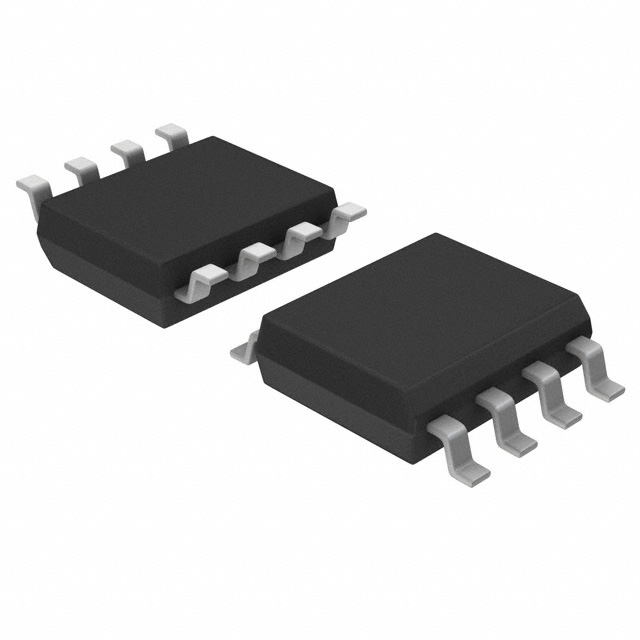Viz Specifikace pro podrobnosti o produktu.

TLC2201ACD
Product Overview
- Category: Integrated Circuit (IC)
- Use: Operational Amplifier
- Characteristics: Low-power, Rail-to-Rail Input/Output, Single Supply
- Package: SOIC (Small Outline Integrated Circuit)
- Essence: The TLC2201ACD is a low-power operational amplifier designed for general-purpose applications. It offers rail-to-rail input and output capabilities, making it suitable for single supply voltage operation.
- Packaging/Quantity: The TLC2201ACD is available in a standard SOIC package. Each package contains one IC.
Specifications
- Supply Voltage: 2.7V to 12V
- Input Offset Voltage: ±0.5mV (maximum)
- Input Bias Current: ±0.5pA (maximum)
- Gain Bandwidth Product: 1MHz
- Slew Rate: 0.6V/µs
- Quiescent Current: 50µA (typical)
Pin Configuration
The TLC2201ACD has a total of 8 pins arranged as follows:
___________
V+ --| |-- V-
Vin+ --| |-- Output
Vin- --| |-- NC
NC --| |-- NC
NC --| |-- NC
GND --|___________|-- NC
Functional Features
- Low-power consumption makes it suitable for battery-powered applications.
- Rail-to-rail input and output allows for maximum dynamic range.
- Single supply operation simplifies circuit design.
- High gain bandwidth product enables accurate signal amplification.
- Low input offset voltage and bias current ensure precise signal processing.
Advantages
- Low power consumption extends battery life in portable devices.
- Rail-to-rail input/output allows for maximum signal swing.
- Single supply operation simplifies circuit design and reduces component count.
- High gain bandwidth product enables accurate amplification of high-frequency signals.
- Low input offset voltage and bias current ensure minimal signal distortion.
Disadvantages
- Limited gain bandwidth product may not be suitable for applications requiring higher frequencies.
- The SOIC package may not be ideal for space-constrained designs.
Working Principles
The TLC2201ACD is an operational amplifier that amplifies the difference between its two input voltages. It operates on a single supply voltage, which is convenient for many applications. The rail-to-rail input and output capabilities allow the amplifier to handle signals that span the entire supply voltage range. This makes it suitable for applications where the input or output signals need to reach the power supply rails.
Detailed Application Field Plans
The TLC2201ACD can be used in various applications, including:
- Sensor Signal Conditioning: Amplifying and processing signals from sensors such as temperature, pressure, or light sensors.
- Audio Amplification: Amplifying audio signals in portable devices like smartphones or MP3 players.
- Battery-Powered Systems: Extending battery life by using the low-power characteristics of the amplifier.
- Industrial Control Systems: Signal conditioning and amplification in industrial control systems.
Alternative Models
If the TLC2201ACD does not meet specific requirements, alternative models with similar characteristics include:
- LM358: Dual operational amplifier with rail-to-rail input/output and low power consumption.
- MCP6001: Single operational amplifier with rail-to-rail input/output and low quiescent current.
- AD8605: Precision operational amplifier with rail-to-rail input/output and low input offset voltage.
These alternative models provide options for different performance requirements and package options.
In conclusion, the TLC2201ACD is a low-power operational amplifier with rail-to-rail input/output capabilities. It is suitable for various applications, including sensor signal conditioning, audio amplification, battery-powered systems, and industrial control systems. While it has advantages such as low power consumption and single supply operation, it may have limitations in terms of gain bandwidth product and package options. Alternative models can be considered based on specific requirements.
Seznam 10 běžných otázek a odpovědí souvisejících s aplikací TLC2201ACD v technických řešeních
Sure! Here are 10 common questions and answers related to the application of TLC2201ACD in technical solutions:
Q: What is TLC2201ACD? A: TLC2201ACD is a precision operational amplifier (op-amp) that is commonly used in various technical applications.
Q: What is the voltage supply range for TLC2201ACD? A: The voltage supply range for TLC2201ACD is typically between ±2.5V and ±18V.
Q: What is the input offset voltage of TLC2201ACD? A: The input offset voltage of TLC2201ACD is typically very low, around 0.25mV.
Q: Can TLC2201ACD operate at high frequencies? A: Yes, TLC2201ACD has a high unity-gain bandwidth, typically around 10MHz, making it suitable for high-frequency applications.
Q: Is TLC2201ACD suitable for low-power applications? A: Yes, TLC2201ACD has a low quiescent current consumption, typically around 500µA, making it suitable for low-power designs.
Q: What is the input common-mode voltage range of TLC2201ACD? A: The input common-mode voltage range of TLC2201ACD typically extends from the negative supply voltage to the positive supply voltage.
Q: Can TLC2201ACD drive capacitive loads? A: Yes, TLC2201ACD has a high output current capability, allowing it to drive capacitive loads without significant degradation in performance.
Q: Does TLC2201ACD have built-in protection features? A: Yes, TLC2201ACD includes built-in protection against electrostatic discharge (ESD) and short-circuit conditions.
Q: Can TLC2201ACD operate in a wide temperature range? A: Yes, TLC2201ACD is designed to operate reliably in a wide temperature range, typically from -40°C to 125°C.
Q: What are some common applications of TLC2201ACD? A: Some common applications of TLC2201ACD include precision instrumentation, data acquisition systems, audio amplification, and sensor signal conditioning.
Please note that the specifications mentioned here are typical values and may vary depending on the specific variant or manufacturer's datasheet.

